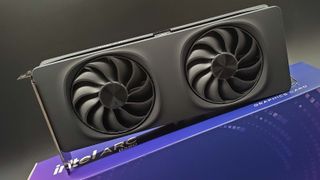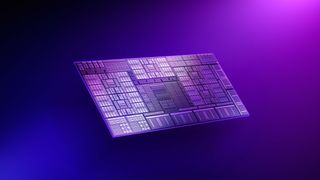Intel recently launched the first discrete graphics card in the Battlemage generation, the Arc B580, late last year. It was generally well received, even though we had our qualms with its performance in a handful of titles in testing. Well, the good news is Intel is now feeling pretty good about its next GPU generation, codename Celestial, too.
I had a chance to sit down for a roundtable with Jim Johnson, SVP of Intel's Client Computing Group and GM, Client Business Group, at the show, along with a handful of fellow journalists.
I asked Johnson: "Are you now more hopeful for the third generation [of Arc] than you were since Battlemage's launch?"
Johnson replied: "I wouldn't use the word hopeful, I would say confident."
"We now have the discrete card and the software that is required to make it perform, our confidence was high enough we launched it integrated with Lunar Lake before we launched it as a discrete product. And so it's an implementation choice, whether we go discrete first or integrated first," Johnson said
For the Xe2 architecture launched, i.e. the architecture behind Battlemage, Intel opted to go integrated first. The GPU inside Lunar Lake is also powered by Xe2, and Intel said prior to that launch that this decision was intended to help it work out the kinks in the software with Lunar Lake before the big chips arrived inside discrete cards.
Plus, any work on this architecture will feed into the next. Working from a more robust foundation will help out big time in developing future hardware.
While we've had our reservations about Battlemage, due to some driver issues with games in our benchmarking suite, including Homeworld 3, largely these cards have been seen to be a big improvement on Alchemist. So, generally, many would say this strategy worked. Intel certainly sees it that way.
"It's really about the software and gaming developers and our drivers being capable on day zero launch, so the games run well, and that's what we take seriously. And that's why, when Michelle (Johnston Holthaus] said, we're committed to discrete graphics business, it's not as only a business, but it's more as a technology capability."
Intel being confident in graphics wouldn't have been on my bingo card even a few years ago, as the company had a pretty rocky start. But with XeSS upscaling, decent ray tracing implementation, and generational improvements, I can see why it's able to puff its chest out a little more.

Though there's still a long way to go to competing with Nvidia's high-end cards. Intel has found a successful formula in the B580, which has reportedly been selling well, though it's an objectively budget card with no claims to high or even midrange performance.
Intel's Tom Petersen has already confirmed the company is working not only on Celestial, the 3rd generation architecture, but the next one after that, which might be known as Druid. He even went as far as stating the Celestial is pretty much "baked", meaning the hardware was done, but the software was still being worked on. And will be until that card launches in the future… sometime.
Swipe to scroll horizontally
| Row 0 - Cell 0 | Intel Arc B570 | Intel Arc B580 |
| Xe cores | 18 | 20 |
| Ray tracing units | 18 | 20 |
| XMX AI engines | 144 | 160 |
| Memory bus | 160-bit | 192-bit |
| Memory | 10 GB | 12 GB |
| Memory bandwidth | 380 GB/s | 456 GB/s |
| Core clockspeed | 2,500 MHz | 2,670 MHz |
| Board power | 150 W | 190 W |
| Video out | 3x DP2.1, 1x HDMI 2.1 | 3x DP2.1, 1x HDMI 2.1 |
Though there is another budget offering coming from Intel in the very near future. The company has announced the second Battlemage card, the Arc B570, will be available from next week. And that's about it for graphics news from Intel at the show.

 1 week ago
10
1 week ago
10









 English (US) ·
English (US) ·